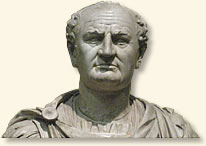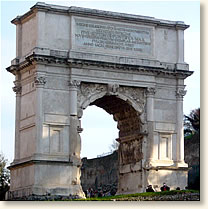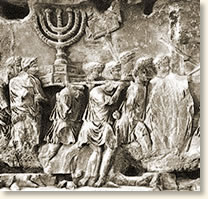|
Rome Celebrates the Vanquishing
of the Jews, 71 AD
In the year 70 AD Rome destroyed
the Jewish Temple at Jerusalem and crushed the revolt of the Jews in Palestine that had begun in 66. The residents of Jerusalem who survived the onslaught were scattered throughout Rome's Empire.

The Emperor Vespasion
|
Although the conflict lingered for another three years, the victory at Jerusalem
in 70 was significant enough to warrant a celebratory triumph in Rome the following
year. The festivities would also help solidify the reign of Vespasian, Rome's
new Emperor. Vespasian had commanded the Roman campaign against the Jews until
the death of Nero in 68. In the resulting chaos, Vespasian passed his command
to his son Titus and returned to Rome where he was declared Emperor late in
the year 69.
The triumph was a gala affair. Presided over by Vespasian and Titus,
it featured piles of booty, including gold relics taken from the destroyed
Jewish Temple, paraded through the streets. Floats depicting key
engagements of the war enthralled the cheering crowd. Thousands of hapless
prisoners were displayed. The highlight of the festival was the parading of
the leader of the Jewish resistance in chains as he was led to his death.
The following account of Vespasian's triumph in
Rome is provided to us by the Jewish historian, Josephus who was present
at the festivities. His description not only provides insight into this victory
celebration but also of the nature of other triumphs staged after a Roman
victory. We join his story in the early morning hours of the day of the festivities:
"During the hours of darkness the whole military force had been led out
in companies and battalions by its officers and had been drawn up - not, as usual,
near the gates of the palaces on the Palatine, but near the temple of Isis. For
Titus and Vespasian had spent the night there, and now, as dawn began to break,
they emerged, crowned in laurel wreaths and wearing the time-honored purple clothes,
and walked to the Octavian colonnade. There the Senate, the magistrates and those
of Equestrian status were waiting for their arrival.
A tribunal had been erected in front of the colonnade, with ivory chairs placed on it for them. As they walked forward to take their seats, all the soldiers raised an immediate cheer, paying abundant testimony to their valor, while Titus and Vespasian sat unarmed, dressed in silk garments and wearing their laurel wreaths. Vespasian acknowledged their acclaim, and, although they were keen to continue cheering, made a sign for silence. As all fell completely quiet, he rose, and, covering most of his head with a veil, made the traditional prayers. Titus followed him in doing likewise. . . Afterwards, donning the triumphal robes and sacrificing to the gods stationed at the gate, they sent the procession on its way through the theatres to give the crowds a better view.

In Rome, The Arch of Titus
celebrating the Roman
victory over the Jews still stands |
It is impossible to do justice in the description of the number of things to be seen and to the magnificence of everything that met the eye, whether in skilled craftsmanship, staggering richness or natural rarity. For almost all the remarkable and valuable objects which have ever been collected, piece by piece, by prosperous people, were on that day massed together, affording a clear demonstration of the might of the Roman Empire. The quantities of silver, gold and ivory, worked into every conceivable form, were not like those usually carried in a triumph, but resembled, as it were, a running river of wealth. Purple cloth of extreme rarity was carried along, some of it fashioned by Babylonian skill into accurate pictorial representations. Translucent gems, embedded in diadems or other objects, were borne in such profusion as to dispel any idea that they were rare. . . In charge of each part of the procession was a number of men in purple and gold costumes, while those selected for the triumph itself wore choice clothes of astonishing richness. Even the prisoners were worth seeing - no disordered mob, but the variety and beauty of their clothes diverted the eye from the disfigurement of their injuries.
The greatest amazement was caused by the floats. Their size gave grounds for alarm about their stability, for many were three or four stories high, and in the richness of their manufacture they provided an astonishing and pleasurable sight. Many were covered in cloth of gold, and worked gold or ivory was fixed on all of them. The war was divided into various aspects and represented in many tableaux which gave a good indication of its character. Here was a fertile land being ravaged, here whole detachments of enemy being slaughtered, others -in flight and others being led off into captivity. Here were walls of colossal size being pounded down by siege-engines, here strongpoints being captured, and here well-defended fortifications overwhelmed. On one float the army could be seen pouring inside the walls, on another was a place running with blood. Others showed defenseless men raising their hands in entreaty, firebrands being hurled at temples or buildings falling on their owners. On yet others were depicted rivers, which, after the destruction and desolation, flowed no longer through tilled fields providing water for men and cattle, but through a land on fire from end to end. It was to such miseries that the Jews doomed themselves by the war. . . Standing on his individual float was the commander of each of the captured cities showing the way he had been taken prisoner. . .

The sack of Jerusalem depicted
on the Arch of Titus
|
Spoil in abundance was carried past. None of it compared with that taken from the Temple in Jerusalem, a golden table many stones in weight and a golden lamp stand, similarly made, which was quite unlike any object in daily use. A centre shaft rose from a base, and from the shaft thin branches or arms extended, in a pattern very like that of tridents, each wrought at its end into a lamp. There were seven of these lamps, thus emphasizing the honour paid by the Jews to the number seven. A tablet of the Jewish Law was carried last of all the spoil. After it came a large group carrying statues of victory, all of them made of ivory and gold. The procession was completed by Vespasian, and, behind him, Titus. Domitian rode on horseback wearing a beautiful uniform and on a mount that was wonderfully well worth seeing.
The procession ended up at the Temple of Jupiter on the Capitol, where the generals got down. They still had to wait for the traditional moment when the news was brought of the death of the enemy leader. In this case he was Simon, son of Giovas, who had passed in procession with the captives, and had been dragged under the lash, with his head in a noose, to a spot near the Forum. That is the traditional place at Rome for the execution of those condemned to death for war-crimes. When his end was announced and a general cheer had arisen, they started the sacrifices, and after completing them with the customary prayers, they retired to the palace. . .
For on that day the city of Rome made holiday for their victory in the war against the Jews, for the end of civil disorder, and for the rising expectations of peace and prosperity."
References:
This eyewitness account appears in: Workman, B. K., They Saw it Happen in Classical Times (1965);
How To Cite This Article:
"Rome Celebrates the Vanquishing of the Jews, 70" EyeWitness to History, www.eyewitnesstohistory.com (2008).
|






